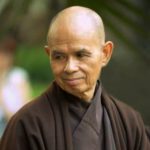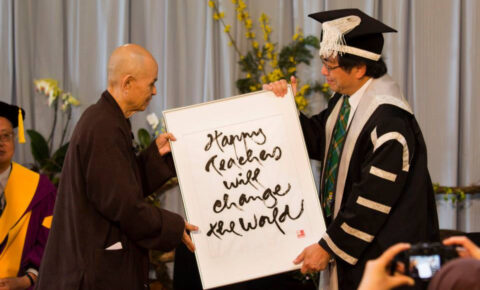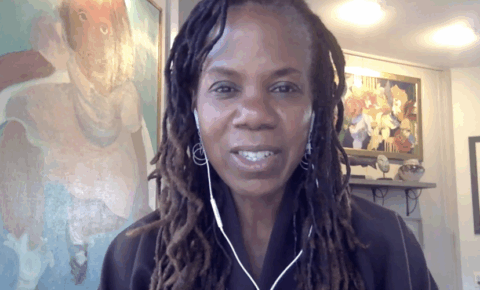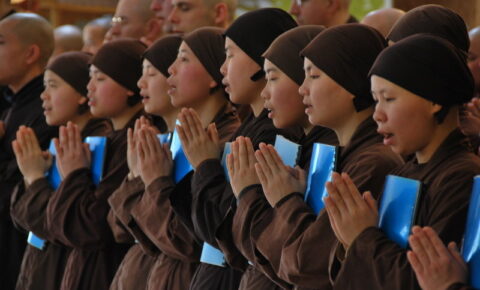 This article was published in Yogacity Magazine in August 2013
This article was published in Yogacity Magazine in August 2013
Wake up New York! Revered Buddhist monk Thich Nhat Hanh is coming to town. While his retreat is sold out, there are still tickets available to his talk on September 7 at NYC’s Beacon Theater. The events are part of his “Nourishing Great Togetherness” Tour and will include a dharma talk on mindfulness practices that can be incorporated into daily routines along with guided meditation, singing, chanting, and prayers for peace. Thich Nhat Hanh will also premiere a calligraphy exhibit on September 7 at ABC Home, hosted by Blue Cliff Monastery and ABC Home, near Union Square. It will run through December.
The Dalai Lama has deemed this humble monk one of the world’s leading spiritual teachers and Martin Luther King nominated him for the Nobel Peace Prize for his activism during the Vietnam War. Many were first exposed to his seminal thinking through Peace is Every Step, a book where he writes “Peace is present right here and now… the question is whether or not we are in touch with it.”
The book introduced the concept of mindfulness, when we are consciously aware of the state of our body, breath, and mind along with the other sensations that surround us rather than being lost in thoughts of anxiety.
By masterfully merging introspective mindfulness practices with compassionate and non-violent action, Thich Nhat Hanh sparked the movement known as Applied Buddhism. At 87, looking decades younger, he offers an inspiring example of how we can move simultaneously toward inner and world peace.
YogaCity NYC’s Lauren Tepper interviewed Thich Nhat Hanh about his essential teachings and intentions for this North American tour.
Lauren Tepper: Can you sum up the message you want to share?
Thich Nhat Hanh: Happiness is possible. Healing is possible. Mindfulness practice can help us to transform stress, violence, discrimination, and alienation. The present moment offers many nourishments that can nurture the seeds of gratitude, joy, and hope within us. All we need to do is allow our mindful steps and conscious breathing to anchor us to each present moment, to be attentive to the changes that are constantly happening within and around us. With these practices, we can let go of stress and enjoy simply breathing.
Lauren Tepper: Which practices do you feel are most essential right now?
Thich Nhat Hanh: When we are busy, we may not think we have time to practice meditation or mindfulness. But in fact, we only need to commit to small pauses to check in with our body and become aware of our breath. In the monastery, we use the clock chime as a reminder to stop whatever we are doing and come back to the present moment. We breathe mindfully for at least three in and out breaths before continuing what we were doing. These small and regular pauses are a part of our practice, and it helps us to have peace and equilibrium throughout the day.
In New York, you may not have a clock that chimes every fifteen minutes, but you do have traffic lights, stop signs, and landmarks along your path between work and home. You can practice intelligently by using some of these external cues as “bells of mindfulness” – reminders to pause and bring some rest and awareness into your life. You can designate certain times throughout the day and certain places as zones of peace by pausing to breathe mindfully.
Lauren Tepper: Tell me about your vision of “Great Togetherness.”
Thich Nhat Hanh: Individualism has brought about alienation, despair, and violence. When we look deeply, we see that we are intricately connected to one another. A flower cannot be by herself alone, she must inter-be with everything else — sun, rain, soil, air, and so on. The well-being of humans cannot be possible without the well-being of plants, animals, and minerals. A collective awakening into our connectedness can help us make wise individual, economic, and political decisions that promote not only our own happiness but the happiness of others as well.
In our community, we practice The Five Mindfulness Trainings – reverence for life, true happiness, true love, true communication, and mindful consumption – which can serve as our global ethics. You can learn more about them on our website. Everyone can practice them in order to ensure the happiness of the individual, the family, the society, and the earth.
There is a kind of radio in our minds called NST, Non-Stop Thinking
Lauren Tepper: You call your upcoming retreat “Transformation and Healing – the Art of Suffering.” Can you explain what you mean by suffering as an ‘art,’ and how this relates to transformation and healing?
Thich Nhat Hanh: Art has the capacity to open our hearts and minds to deeper truths and to help us touch beauty. It is the same with suffering. As practitioners, we learn to relate to suffering in a beneficial way. It’s like the way we grow lotus flowers. Without the mud you cannot grow the flowers. Suffering is a kind of mud that we need in order to grow the feelings of joy and happiness. If we know how to skillfully apply the practices of mindfulness, concentration, and loving-kindness in the midst of our suffering, we can transform it into greater understanding, compassion, and freedom.
Lauren Tepper: How do you remain hopeful about peace amidst all the violence in the world?
Thich Nhat Hanh: Violence in the world is related to our lack of peace in our daily lives. Many of us are keenly attentive to the political, social, and environmental spheres, yet we have lost very basic contact with what is going on in our own body and mind. When we practice mindful breathing and mindful walking on a daily basis, we are bringing peace into our lives in a concrete way. We become aware and can take better care of our physical and mental health.
This is the way we nurture peace and strengthen our capacity to face the larger challenges that we collectively face. We embody the peace that we would like to see in the world.
Lauren Tepper: How can we stay present in meditation when we feel physical pain or mental anguish?
Thich Nhat Hanh: Meditation should be pleasant. When there is pain it may be that we need a different cushion or a different sitting position, even if it is on a chair. At times of course some pain is inevitable; but suffering is optional.
Suppose someone is hit by an arrow. If a second arrow comes and strikes at exactly the same spot, the pain may be unbearable. The worry, the anger, the despair of our mind is the second arrow. If we don’t let the second arrow hit us, we will have enough capacity to handle the physical pain. So when we have some pain in our body, the practice is to breathe in and out, to recognize it as it is and not to exaggerate it.
Lauren Tepper: How can we move beyond the mental knowledge that we are all connected spiritual beings, into really feeling that connection in our day to day lives?
Thich Nhat Hanh: There is a kind of radio in our minds called NST, Non-Stop Thinking. We have to turn off that kind of radio in order to feel connected to life. Of course there is right thinking which helps us – but most of our thinking is wrong thinking. When we are walking from one place to another we turn off that radio. We focus entirely on our in-breath, our out-breath, and our steps. With each step we touch earth, and in this way we can experience all the wonders of life. It is not difficult to turn off the radio inside if you find pleasure in breathing and walking.
You don’t need to use force. Just pay attention to your in-breath and out-breath – do not interfere. Learning how to quiet mental discourse can help us connect more deeply to our loved ones and everyone around us.
Lauren Tepper: How do you fit self-care into your busy traveling and teaching schedule so as not to get burned out?
Thich Nhat Hanh: Whether sitting on a bus or an airplane, or going from place to place, it is possible to get rest and nourishment in every breath. Mindfulness can help us recognize promptly the tension and stress building up, and we can relax by becoming conscious of our natural breathing. Taking good care of ourselves is the kindest and most important service that we may offer to our loved ones and the world.
Lauren Tepper: If you could give just one piece of advice to someone who is interested in practicing meditation, what would it be?
Thich Nhat Hanh: Find a sangha: a community of practitioners who come together to share the practice and encourage each other in the practice. The sangha is like our body and we are like the cells.
A lot of New Yorkers come to Blue Cliff Monastery to experience this. There are also local sanghas in New York (to find one you can go to iamhome.org. When you allow yourself to be embraced by that collective energy, you feel much better.
Calligraphies will be on sale during the Exhibition at ABC Home.
23 August 2013, from YogaCity






Share Your Reflections